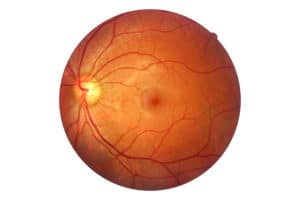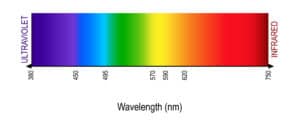Share this post
Just what we need to protect our eyes and skin in 2020 and beyond?
Perhaps you have heard of lutein or zeaxanthin, or the term “carotenoids”, which describes the larger family they belong to. Better known members of this family are lycopene, found at high levels in tomatoes, and beta-carotene, precursor to vitamin A.
Xanthophylls are members of the carotenoid family that contain oxygen as a part of their chemical structure. The word xanthophyll is derived from the Greek words “xanthos”, meaning yellow, and “phyllon”, meaning leaf, reflecting their presence in yellow leaf pigments. And true to form, the xanthophylls lutein and zeaxanthin are yellowish-orange in color, which also sheds light (no pun intended) on the portion of the electromagnetic spectrum that they absorb. Lutein and zeaxanthin both highly absorb light having a wavelength of roughly 400 to 500 nm, which corresponds with the blue light portion of the visible spectrum.[1] Because lutein and zeaxanthin absorb these wavelengths, their visible appearance is the colors they do not absorb.
One reason that lutein and zeaxanthin help protect the eyes is because they absorb blue light.
Dietarily, we ingest lutein and zeaxanthin when we consume green leafy vegetables, with cooked kale and spinach both delivering more than 10 mg/100 g; eggs, with the yolk having the highest amounts of these nutrients; and pistachio nuts, which also deliver more than 1 mg/100 g.[2] Other foods high in lutein and zeaxanthin include orange peppers, squash, parsley, and romaine lettuce.
Absorption of these carotenoids, which are fat-soluble nutrients, may be enhanced by consumption with other fats, much as for other fat-soluble nutrients. For example, the consumption of a salad with fat-free dressing negligibly increases plasma carotenoid content while consumption with 6 or 28 g of canola oil dose-dependently increases it.[3] There is not a dietary guideline for lutein or zeaxanthin intake, however research suggests that one should consume 6 mg/day to prevent age-related macular degeneration.[4] However, dietary studies have shown that U.S. adults only consume 1 to 2 mg/day.[5]
In the human body, we find the highest levels of lutein and zeaxanthin (L/Z) in three organs in particular: the eyes, brain, and skin. The eyes, by far, contain the highest levels of these nutrients. Concentrated in the fovea, the central region of the macula (part of the retina) where the density of cones is the greatest, the concentration of zeaxanthin is about 1000 times higher than other tissues.[6] The concentration of lutein is highest in more peripheral regions of the macula bordering this.[7] High levels of lutein and zeaxanthin are also found in the brain and skin.[8],[9]
Human retina. The central, dark region, is the macula, and the light region to the left is the optic nerve.
One reason that these molecules help protect the eyes is because they absorb blue light.1 Blue light damages the retina through a photooxidation reaction with lipofuscin, a mixture of lipids, proteins, and fluorescent compounds that are a byproduct of incompletely digested phagocytosed photoreceptor cells.[10] With our digital technology-related increase in exposure to blue light that computer screens, digital devices, energy-efficient indoor lighting, and television screens emit, we see an increase in problems related to blue light exposure. This includes dry eyes, eye strain, and eye fatigue, [11],[12] and long term, can contribute to gradual loss of visual function and conditions such as age-related macular degeneration.[13]
Lutein and zeaxanthin not only protect the eyes from blue light exposure, they also protect the skin.
Lutein and zeaxanthin not only protect the eyes from blue light exposure, they also protect the skin. Although the damaging effects of the UV portion of the spectrum are well known, many are less aware of the oxidative and DNA-damaging effects that blue light exposure also has on the skin.[14],[15],[16] Although the magnitude of damage is less than UV rays impart, because of the regular exposure we have to blue light, and the lack of protection that sunscreen provides (and that we typically don’t wear sunscreen in the confines of our home),[17] the cumulative effect of blue light exposure is significant. Blue light exposure not only causes its own damage, it renders us more susceptible to damage from the intense UV-A and UV-B rays as well. Blue light exposure even increases our production of melanin[18] – which also suggests our body inherently knows to do the things that help protect us from it.
Herein, we’ll take a closer look at the protection that lutein and zeaxanthin offer our eyes and skin not just from blue light, but also as antioxidant protectors.
Eye health
As noted, one of the primary mechanisms by which lutein and zeaxanthin help protect the eyes is by the absorption of blue light. Lutein and zeaxanthin also quench singlet molecular oxygen, prevent lipid peroxidation, and induce nuclear factor erythroid2-related factor 2 (Nrf2)-dependent antioxidant transcription.[19],[20],[21],[22] They act as anti-inflammatories as well,[23] and thus may be helpful in conditions such as uveitis,[24] in which substantial damage is also caused by inflammation.
Correlation has been shown between low macular levels of L/Z and the development of age-related macular degeneration.
Dietary supplementation of lutein or L/Z has been shown to increase their levels not only in the serum but also in the macula, typically evaluated by assessment of macular pigment optical density (MPOD), a non-invasive test that can easily be performed.[25],[26],[27] Interestingly, in one study looking at lutein and zeaxanthin in combination or as monotherapies, it was shown that zeaxanthin alone did not significantly impact macular levels.25 Increases in MPOD also may depend on levels at baseline, with one study showing improvements only in those who had lower levels initially.[28] As fat-soluble antioxidants that gradually accumulate in their destination tissues, the duration of intervention prior to assessment of outcomes usually is a minimum of two to six months.
Multiple studies have assessed how L/Z supplementation affects the vision of healthy individuals, typically evaluating the effect on visual acuity or symptoms related to intense light exposure (referred to as glare). With visual stressors such as the intense light of a camera flash, it takes some time for the eye to recover and there are aspects of discomfort. A higher MPOD is correlated with faster photostress recovery and reduced glare discomfort and disability.[29],[30] Correlation has been shown between low macular levels of L/Z and the development of age-related macular degeneration (AMD).[31],[32] Dietary intake studies also suggest this relationship, particularly in those with a high genetic risk of the condition.[33],[34],[35]
In one randomized, double-blind, placebo-controlled trial, healthy subjects were supplemented with a combination of 10 mg of lutein and 2 mg of zeaxanthin or placebo daily for one year.[36] Significant improvements in photostress recovery as well as chromatic contrast were seen with time, paralleling the time-related increase in MPOD. In another study in which participants received 10.5 mg of lutein and 0.96 mg of zeaxanthin daily for six months, those who had lower MPOD levels at baseline were more likely to respond to supplementation and experience a reduction in glare sensitivity.[37] In a single-arm study, supplementation of 10 mg of lutein and 2 mg of zeaxanthin daily for six months also was shown to significantly improve visual performance under glare conditions.[38]
Improvements in night vision, contrast sensitivity, and global visual function have been seen with regular, daily supplementation of lutein and zeaxanthin.
Numerous additional studies have shown that supplementation with lutein, usually accompanied by a small amount of zeaxanthin at a 10:1 to 10:2 ratio, improves these and other aspects of vision in healthy adults. At doses of L/Z ranging from as little as 6 mg/day to 22 mg/day, improvements in vision have been seen as early as 45 days, although typically, assessment occurred after six months of supplementation.[39],[40],[41],[42] Improvements in parameters related to night vision,40 contrast sensitivity,41,42 and global visual function42 were seen with regular, daily supplementation of L/Z.
Not surprisingly, several studies have looked at the effect L/Z supplementation has on vision and other outcomes in individuals with AMD. In individuals with early AMD, supplementation of 20 mg lutein with 2 mg zeaxanthin for 12 months improved letter contrast sensitivity.[43] In a longer, five-year study of patients with AMD, supplementation of L/Z (10 and 2 mg/day) significantly reduced the risk of progression to late AMD.[44] It also reduced the risk of development of neovascular AMD in individuals with large drusen bilaterally, but not those who already had late AMD in one eye. In an additional assessment of the same population, it was found that L/Z supplementation significantly reduced the risk of needing cataract surgery in individuals in the lowest quintile of dietary L/Z intake.[45] Three additional studies, having a duration of six months to two years, found that daily supplementation of 10 mg of lutein, with zeaxanthin ranging from 1 to 2 mg, significantly improved contrast sensitivity[46],[47] and visual acuity.47,[48]
It should be noted that in one of the studies finding improved contrast sensitivity,46 supplementation also included small amounts of vitamins B3, E, and C, zinc, and copper, while in one of the studies showing improved visual acuity,48 supplementation included vitamins E and C, zinc, copper, and astaxanthin. Studies suggest there may be synergistic effects of the antioxidant vitamins with L/Z while astaxanthin, another member of the carotenoid family, also is known to benefit vision.10,[49],[50]
Skin health
Lutein and zeaxanthin not only protect the skin from the damaging effects of blue light, their antioxidant properties also help protect it from UV radiation. Animal studies have shown that supplementation of lutein as a monotherapy, or in combination with a small amount of zeaxanthin, reduces inflammation and edema, reactive oxygen species production, and epidermal hyperproliferation with exposure to UV-B radiation.[51],[52] When subject to routine exposure with UV-B light for 16 weeks, feed supplementation of L/Z significantly attenuated multiple parameters of photoaging as well as UV exposure-related tumor burden.52
Electromagnetic spectrum. Ultraviolet (UV) rays have a wavelength slightly shorter than blue light.
Clinical studies have looked at the impact that oral, as well as topical, use of L/Z have on various parameters related to skin health. In one such study, healthy individuals with fair to olive skin having mild to moderately dryness were supplemented with 12 mg of L/Z or placebo daily for a period of 12 weeks.[53] The skin tone of individuals taking L/Z was significantly lightened and improved overall, perhaps indicative of the absorption of blue light and subsequent reduction of melanin production. In those taking L/Z, the minimal erythema dose (which mimics the redness and inflammatory response to sunlight) and elastic recovery were significantly increased relative to baseline, and higher than those receiving placebo however the difference was not significant.
Lutein and zeaxanthin not only protect the skin from the damaging effects of blue light, their antioxidant properties also help protect it from UV radiation.
In another study, healthy women, age 25 to 50 years, were instructed to administer L/Z orally (10.5 mg/day), topically (a standardized dilution in butylene glycol), or topically and orally each day for a period of 12 weeks.[54] Although the combination of topical and oral treatment typically had the greatest effects, both topical and oral treatment with L/Z led to a significant increase in skin lipids, hydration, elasticity, and minimal erythema dose and a reduction in lipid peroxidation. Although there was an increase in skin lipids, questionnaires did not indicate subjects found their skin to be too oily, suggesting the increase may be attributable to things other than just sebaceous secretions, which often lead to such complaints.
Clearly, there are many reasons these xanthophylls should be considered for supplement protocols to support ocular and skin health, as well as anti-aging protocols, in 2020 and beyond.
Click here to see References[1] Roberts RL, et al. Lutein and zeaxanthin in eye and skin health. Clin Dermatol. 2009 Mar-Apr;27(2):195-201.
[2] Eisenhauer B, et al. Lutein and zeaxanthin – food sources, bioavailability and dietary variety in age-related macular degeneration protection. Nutrients. 2017 Feb 9;9(2):120.
[3] Brown MJ, et al. Carotenoid bioavailability is higher from salads ingested with full-fat than with fat-reduced salad dressings as measured with electrochemical detection. Am J Clin Nutr. 2004 Aug;80(2):396-403.
[4] Rasmussen HM, Johnson EJ. Nutrients for the aging eye. Clin Interv Aging. 2013;8:741-8.
[5] Mares-Perlman JA, et al. The body of evidence to support a protective role for lutein and zeaxanthin in delaying chronic disease. Overview. J Nutr. 2002 Mar;132(3):518S-24S.
[6] Landrum JT, et al. Analysis of zeaxanthin distribution within individual human retinas. Methods Enzymol. 1999;299:457-67.
[7] Bone RA, et al. Distribution of lutein and zeaxanthin stereoisomers in the human retina. Exp Eye Res. 1997 Feb;64(2):211-8.
[8] Vishwanathan R, et al. Macular lutein and zeaxanthin are related to brain lutein and zeaxanthin in primates. Nutr Neurosci. 2013 Jan;16(1):21-9.
[9] Peng YM, et al. Concentrations and plasma-tissue-diet relationships of carotenoids, retinoids, and tocopherols in humans. Nutr Cancer. 1995;23(3):233-46.
[10] Roberts JE, Dennison J. The photobiology of lutein and zeaxanthin in the eye. J Ophthalmol. 2015;2015:687173.
[11] Cheng HM, et al. Does blue light filter improve computer vision syndrome in patients with dry eye. Life Science Journal. 2014;11(6):612-5.
[12] Rosenfield M. Computer vision syndrome (aka digital eye strain). Optometry in Practice. 2016 Feb 16;17(1):1-10.
[13] Fletcher AE, et al. Sunlight exposure, antioxidants, and age-related macular degeneration. Arch Ophthalmol. 2008 Oct;126(10):1396-403.
[14] Nakashima Y, et al. Blue light-induced oxidative stress in live skin. Free Radic Biol Med. 2017 Jul;108:300-10.
[15] Dong K, et al. Blue light disrupts the circadian rhythm and create damage in skin cells. Int J Cosmet Sci. 2019 Dec;41(6):558-62.
[16] Bennet D, et al. An ultra-sensitive biophysical risk assessment of light effect on skin cells. Oncotarget. 2017 Jul 18;8(29):47861-75.
[17] Roberts RL, et al. Lutein and zeaxanthin in eye and skin health. Clin Dermatol. 2009 Mar-Apr;27(2):195-201.
[18] Regazzetti C, et al. Melanocytes sense blue light and regulate pigmentation through opsin-3. J Invest Dermatol. 2018 Jan;138(1):171-8.
[19] Böhm F, et al. Interactions of dietary carotenoids with singlet oxygen (1O2) and free radicals: potential effects for human health. Acta Biochim Pol. 2012;59(1):27-30.
[20] Sujak A, et al. Lutein and zeaxanthin as protectors of lipid membranes against oxidative damage: the structural aspects. Arch Biochem Biophys. 1999 Nov 15;371(2):301-7.
[21] Frede K, et al. Lutein activates the transcription factor Nrf2 in human retinal pigment epithelial cells. J Agric Food Chem. 2017 Jul 26;65(29):5944-52.
[22] Zou X, et al. Zeaxanthin induces Nrf2-mediated phase II enzymes in protection of cell death. Cell Death Dis. 2014 May 8;5:e1218.
[23] Johnson EJ. Role of lutein and zeaxanthin in visual and cognitive function throughout the lifespan. Nutr Rev. 2014 Sep;72(9):605-12.
[24] He RR, et al. Antioxidant properties of lutein contribute to the protection against lipopolysaccharide-induced uveitis in mice. Chin Med. 2011 Oct 31;6(1):38.
[25] Schalch W, et al. Xanthophyll accumulation in the human retina during supplementation with lutein or zeaxanthin – the LUXEA (LUtein Xanthophyll Eye Accumulation) study. Arch Biochem Biophys. 2007 Feb 15;458(2):128-35.
[26] Arnold C, et al. Macular xanthophylls and ω-3 long-chain polyunsaturated fatty acids in age-related macular degeneration: a randomized trial. JAMA Ophthalmol. 2013 May;131(5):564-72.
[27] Richer S, et al. LAST II: differential temporal responses of macular pigment optical density in patients with atrophic age-related macular degeneration to dietary supplementation with xanthophylls. Optometry. 2007 May;78(5):213-9.
[28] Obana A, et al. Changes in macular pigment optical density and serum lutein concentration in Japanese subjects taking two different lutein supplements. PLoS One. 2015 Oct 9;10(10):e0139257.
[29] Stringham JM, et al. Macular pigment and visual performance in glare: benefits for photostress recovery, disability glare, and visual discomfort. Invest Ophthalmol Vis Sci. 2011 Sep 22;52(10):7406-15.
[30]Hammond BR Jr, et al. Glare disability, photostress recovery, and chromatic contrast: relation to macular pigment and serum lutein and zeaxanthin. Invest Ophthalmol Vis Sci. 2013 Jan 17;54(1):476-81.
[31] Obana A, et al. Macular carotenoid levels of normal subjects and age-related maculopathy patients in a Japanese population. Ophthalmology. 2008 Jan;115(1):147-57.
[32] Beatty S, et al. Macular pigment and risk for age-related macular degeneration in subjects from a Northern European population. Invest Ophthalmol Vis Sci. 2001 Feb;42(2):439-46.
[33] Ho L, et al. Reducing the genetic risk of age-related macular degeneration with dietary antioxidants, zinc, and ω-3 fatty acids: the Rotterdam study. Arch Ophthalmol. 2011 Jun;129(6):758-66.
[34] Tan JS, et al. Dietary antioxidants and the long-term incidence of age-related macular degeneration: the Blue Mountains Eye Study. Ophthalmology. 2008 Feb;115(2):334-41.
[35] Seddon JM, et al. Dietary carotenoids, vitamins A, C, and E, and advanced age-related macular degeneration. JAMA. 1994 Nov 9;272(18):1413-20.
[36] Hammond BR, et al. A double-blind, placebo-controlled study on the effects of lutein and zeaxanthin on photostress recovery, glare disability, and chromatic contrast. Invest Ophthalmol Vis Sci. 2014 Dec 2;55(12):8583-9.
[37] Rodriguez-Carmona M, et al. The effects of supplementation with lutein and/or zeaxanthin on human macular pigment density and colour vision. Ophthalmic Physiol Opt. 2006 Mar;26(2):137-47.
[38] Stringham JM, Hammond BR. Macular pigment and visual performance under glare conditions. Optom Vis Sci. 2008 Feb;85(2):82-8.
[39] Pescosolido N, et al. The effect of night vision goggles on the retinocortical bioelectrical activity and its improvement by food supplement. Panminerva Med. 2012 Dec;54(1 Suppl 4):83-92.
[40] Loughman J, et al. The impact of macular pigment augmentation on visual performance using different carotenoid formulations. Invest Ophthalmol Vis Sci. 2012 Nov 29;53(12):7871-80.
[41] Kvansakul J, et al. Supplementation with the carotenoids lutein or zeaxanthin improves human visual performance. Ophthalmic Physiol Opt. 2006 Jul;26(4):362-71.
[42] Morganti P, et al. Protective effects of oral antioxidants on skin and eye function. Skinmed. 2004 Nov-Dec;3(6):310-6.
[43] Sabour-Pickett S, et al. Supplementation with three different macular carotenoid formulations in patients with early age-related macular degeneration. Retina. 2014 Sep;34(9):1757-66.
[44] Age-Related Eye Disease Study 2 (AREDS2) Research Group, et al. Secondary analyses of the effects of lutein/zeaxanthin on age-related macular degeneration progression: AREDS2 report No. 3. JAMA Ophthalmol. 2014 Feb;132(2):142-9.
[45] Age-Related Eye Disease Study 2 (AREDS2) Research Group, et al. Lutein/zeaxanthin for the treatment of age-related cataract: AREDS2 randomized trial report no. 4. JAMA Ophthalmol. 2013 Jul;131(7):843-50.
[46] Wolf-Schnurrbusch UE, et al. Oral lutein supplementation enhances macular pigment density and contrast sensitivity but not in combination sith polyunsaturated fatty acids. Invest Ophthalmol Vis Sci. 2015 Dec;56(13):8069-74.
[47] Richer S, et al. Double-masked, placebo-controlled, randomized trial of lutein and antioxidant supplementation in the intervention of atrophic age-related macular degeneration: the Veterans LAST study (Lutein Antioxidant Supplementation Trial). Optometry. 2004 Apr;75(4):216-30.
[48] Piermarocchi S, et al. Carotenoids in Age-related Maculopathy Italian Study (CARMIS): two-year results of a randomized study. Eur J Ophthalmol. 2012 Mar-Apr;22(2):216-25.
[49] Wrona M, et al. Zeaxanthin in combination with ascorbic acid or alpha-tocopherol protects ARPE-19 cells against photosensitized peroxidation of lipids. Free Radic Biol Med. 2004 May 1;36(9):1094-101.
[50] Kidd P. Astaxanthin, cell membrane nutrient with diverse clinical benefits and anti-aging potential. Altern Med Rev. 2011 Dec;16(4):355-64.
[51] Lee EH, et al. Dietary lutein reduces ultraviolet radiation-induced inflammation and immunosuppression. J Invest Dermatol. 2004 Feb;122(2):510-7.
[52] González S, et al. Dietary lutein/zeaxanthin decreases ultraviolet B-induced epidermal hyperproliferation and acute inflammation in hairless mice. J Invest Dermatol. 2003 Aug;121(2):399-405.
[53] Juturu V, et al. Overall skin tone and skin-lightening-improving effects with oral supplementation of lutein and zeaxanthin isomers: a double-blind, placebo-controlled clinical trial. Clin Cosmet Investig Dermatol. 2016 Oct 7;9:325-32.
[54] Palombo P, et al. Beneficial long-term effects of combined oral/topical antioxidant treatment with the carotenoids lutein and zeaxanthin on human skin: a double-blind, placebo-controlled study. Skin Pharmacol Physiol. 2007;20(4):199-210.
The information provided is for educational purposes only. Consult your physician or healthcare provider if you have specific questions before instituting any changes in your daily lifestyle including changes in diet, exercise, and supplement use.
Share this post
Dr. Carrie Decker
Related posts
The Healthspan Imperative
Why healthspan is the new focus of geroscience “Life is short, and the older you get, the more you feel it. Indeed, the shorter it is.” This quote by actor Viggo Mortensen sums up how many people feel when they reach middle age and beyond. They start to realize how important it is to…
Herbal Approaches to Low Libido in Menopause
Menopause is associated with many often-lamented symptoms that can have drastic effects on a woman’s comfort, happiness, and daily life activities. Hot flashes, night sweats, and mood swings are commonly discussed because of their prevalence (up to 80% of women experience hot flashes during menopause[i]). Though less often discussed, low sexual desire is another…
Health Benefits of Alpha-Lipoic Acid
Its use in weight management, metabolic syndrome, and diabetes Alpha-lipoic acid (ALA), also known simply as lipoic acid, is a naturally-occurring substance that is an essential cofactor for several enzymes.[1] ALA, synthesized in the body from a medium-chain fatty acid known as octanoic acid,[2] plays a key role in mitochondrial metabolism and energy production.[3],[4]…
Molecular Hydrogen and Autoimmune Disease
Multiple clinical studies report improvements in autoimmune disease with hydrogen treatment Although hydrogen (H2) is well known as an alternative fuel, recognized as such in the Energy Policy Act of 1992, only in 2007 did it begin to really make the scene in medicine. Although used for the purpose of preventing decompression sickness in…
Seaweed for Immunity
Complex seaweed-derived compounds known as fucoidans support immune function and longevity Picture a frozen earth 635 million years ago, the planet at last beginning to thaw from an extraordinary ice age that blanketed land and sea. As the permafrost softens and melts, new life emerges from the ocean depths: sea plants.[1] The earth’s first…
Erectile Dysfunction and B Vitamins
Could a simple intervention like B vitamins improve ED? Multiple human studies suggest they might By far, the most common concern that comes up in discussions of male sexual health is erectile dysfunction. A large, multinational survey, published in 2004, found that erectile dysfunction (commonly referred to simply as ED) affects approximately 16% of…
Categories
- Botanicals (56)
- GI Health (53)
- Healthy Aging (121)
- Immune Support (39)
- In The News (39)
- Kids Health (21)
- Stress and Relaxation (50)
- Uncategorized (1)
- Video (9)
- Vitamins & Minerals (51)






